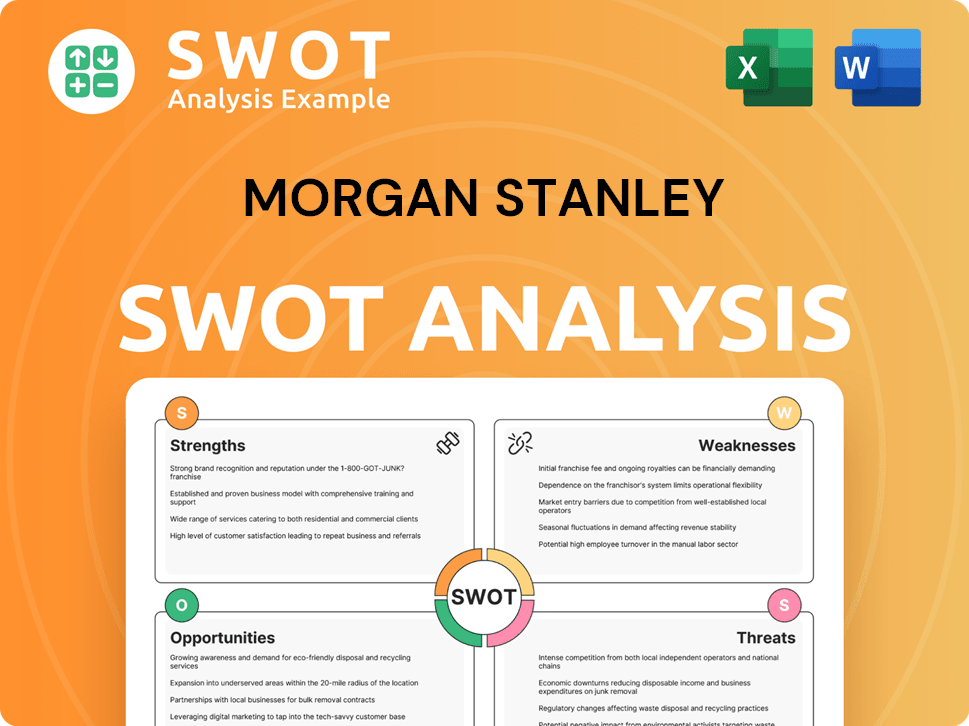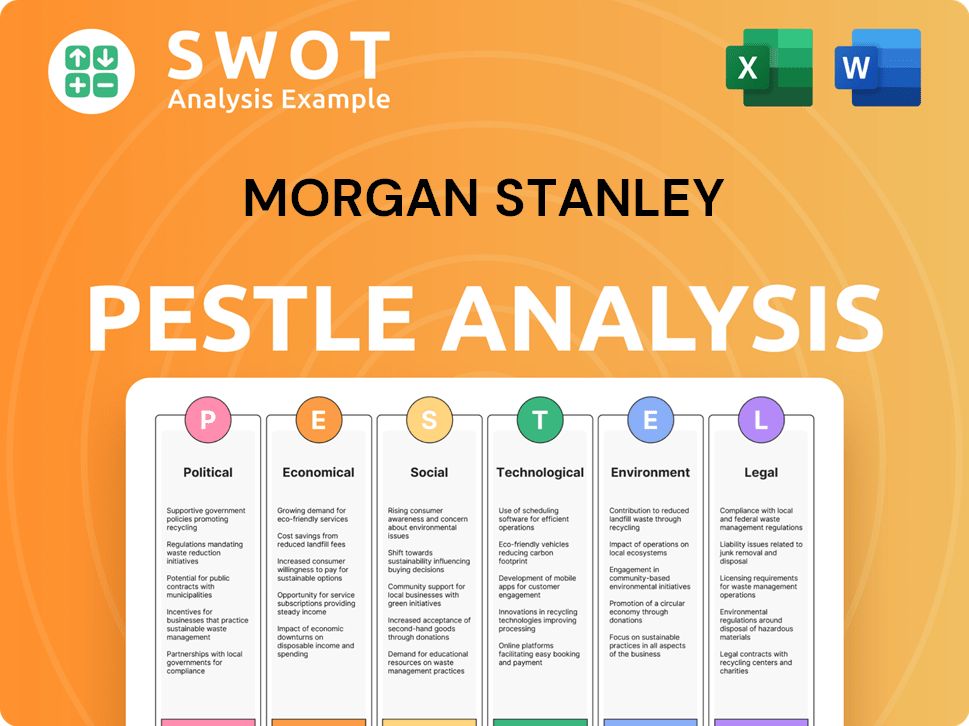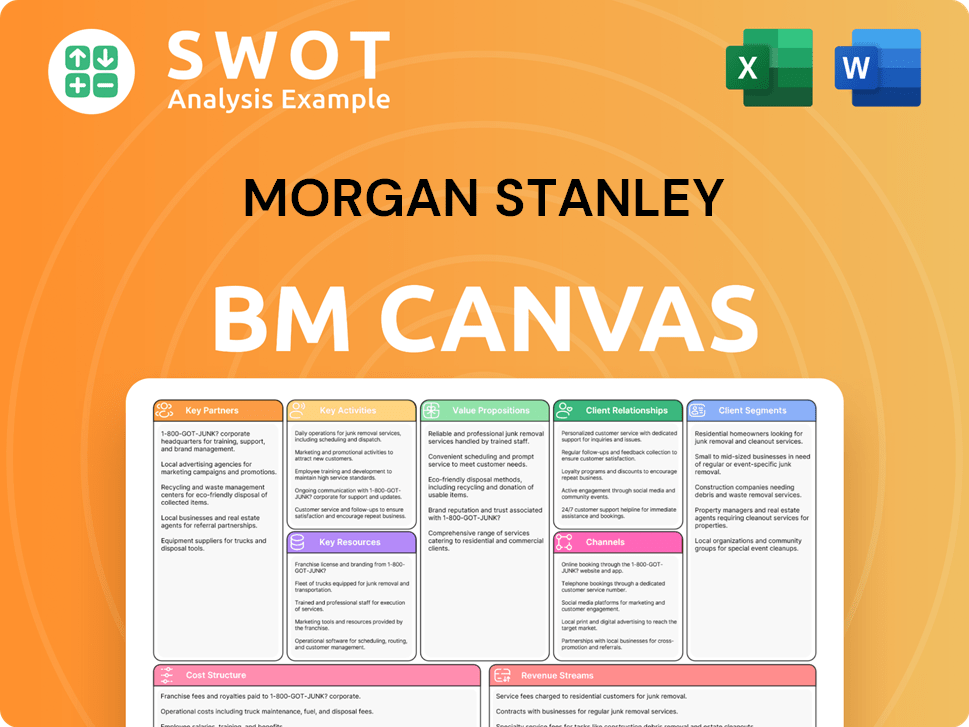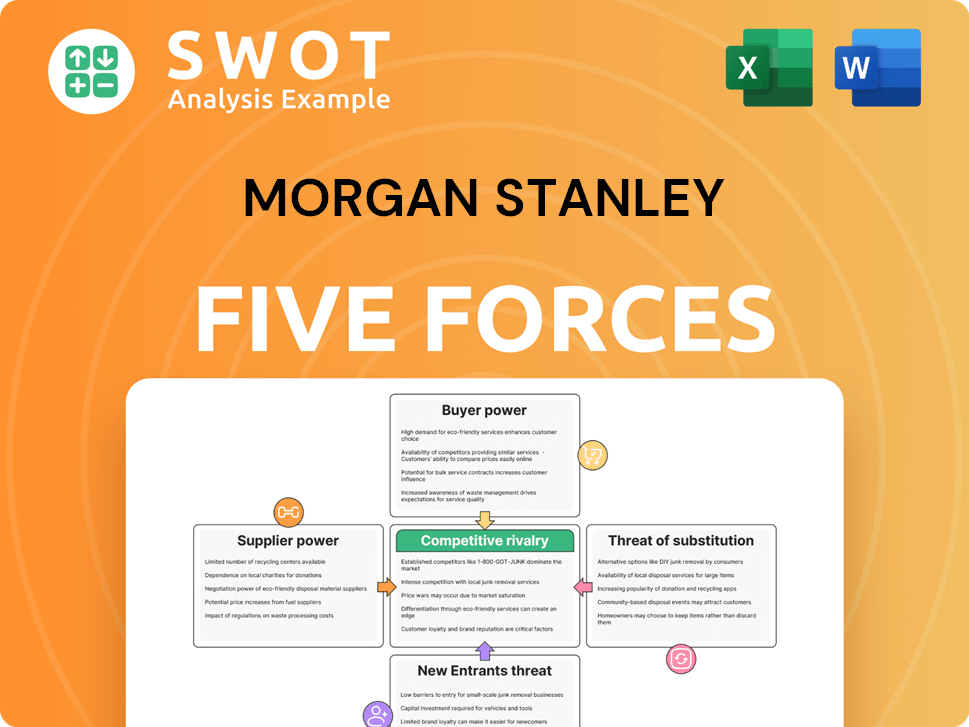Morgan Stanley Bundle
How did Morgan Stanley rise to become a Wall Street titan?
Ever wondered how a financial giant like Morgan Stanley came to be? The story begins amidst the upheaval of the Great Depression and a pivotal piece of legislation. From its roots in 1935 New York City, Morgan Stanley's journey is a compelling narrative of adaptation and expansion within the dynamic world of financial services.

The Morgan Stanley SWOT Analysis reveals the strategic evolution of the company. Understanding the Morgan Stanley history is crucial for grasping its current position. This evolution, from its Morgan Stanley founding date to its current global presence, reflects its ability to navigate economic shifts and regulatory changes. Exploring the Morgan Stanley company’s past offers valuable insights into its future trajectory and impact on the economy.
What is the Morgan Stanley Founding Story?
The story of Morgan Stanley began on September 16, 1935. It was founded by Henry S. Morgan and Harold Stanley, marking a significant moment in Morgan Stanley history and the broader landscape of financial services.
The formation of Morgan Stanley company was a direct response to the Glass-Steagall Act of 1933. This act separated commercial and investment banking, leading to the creation of an independent entity focused on investment banking.
The founders' backgrounds at J.P. Morgan & Co. provided them with expertise and industry connections. Their vision was to offer specialized services to corporations and governments, filling a critical need in the evolving financial sector.
Henry S. Morgan, grandson of J.P. Morgan, and Harold Stanley, a senior partner at J.P. Morgan & Co., established Morgan Stanley.
- The Glass-Steagall Act of 1933 prompted the separation of commercial and investment banking, creating an opportunity for Morgan Stanley.
- Their initial business model centered on advisory services, underwriting securities, and facilitating mergers and acquisitions.
- The company's name reflected the founders' surnames, emphasizing their personal commitment and leveraging their reputations.
- The early funding likely came from the founders' capital and their network, reflecting the industry's reliance on personal connections.
Morgan Stanley SWOT Analysis
- Complete SWOT Breakdown
- Fully Customizable
- Editable in Excel & Word
- Professional Formatting
- Investor-Ready Format

What Drove the Early Growth of Morgan Stanley?
The early growth of Morgan Stanley, a key chapter in the Morgan Stanley history, was marked by its swift establishment as a major player in investment banking. The firm quickly secured significant mandates, demonstrating its capabilities in underwriting and advisory services. The initial team comprised experienced professionals, ensuring a high level of expertise from the outset. Its first office was located in New York City, the heart of the American financial industry.
A notable early achievement for the Morgan Stanley company was its role in the U.S. Steel bond offering in 1938, a large and complex transaction that solidified its reputation. This early success set the stage for future growth. The firm's focus on providing independent advice helped it stand out in the competitive landscape of financial services.
Throughout the 1940s and 1950s, Morgan Stanley expanded its client base, advising major corporations on capital raising and strategic initiatives. The firm's entry into new markets was often driven by the evolving needs of its clients. As the post-war economy boomed, the demand for corporate finance and M&A advisory services increased, which Morgan Stanley capitalized on.
While specific early acquisitions or mergers are less documented in its initial decades, the firm's growth was primarily organic, driven by its strong relationships and reputation for independent advice. Leadership transitions were gradual, with the founders remaining influential for a significant period. This approach fostered stability and a consistent focus on client needs.
The market reception to Morgan Stanley was largely positive, as its focus on pure investment banking filled a critical gap created by the Glass-Steagall Act. The competitive landscape included other emerging investment banks. Morgan Stanley distinguished itself through its pedigree and commitment to advisory excellence. For insights into its rivals, consider the Competitors Landscape of Morgan Stanley.
Morgan Stanley PESTLE Analysis
- Covers All 6 PESTLE Categories
- No Research Needed – Save Hours of Work
- Built by Experts, Trusted by Consultants
- Instant Download, Ready to Use
- 100% Editable, Fully Customizable

What are the key Milestones in Morgan Stanley history?
The Morgan Stanley history is marked by significant achievements and strategic pivots that have shaped its position in the financial services industry. From its founding to its evolution through various market cycles, the firm has consistently adapted to maintain its competitive edge. The company's journey reflects broader trends in Wall Street and the global economy, demonstrating its resilience and ability to innovate. Understanding the Morgan Stanley company's milestones provides valuable insights into its enduring influence and future prospects. For a deeper understanding of the firm's ownership structure, you can explore the details in this article: Owners & Shareholders of Morgan Stanley.
| Year | Milestone |
|---|---|
| 1935 | Founded by Harold Stanley and Henry S. Morgan after the Glass-Steagall Act separated commercial and investment banking. |
| 1956 | Played a key role in the initial public offering (IPO) of Ford Motor Company, one of the largest public offerings at the time. |
| Post-War Era | Expanded its global presence by establishing a significant presence in London and Tokyo, among the first U.S. investment banks to do so. |
| 2008 | Converted into a bank holding company during the global financial crisis to access Federal Reserve funding. |
| 2013 | Acquired Smith Barney from Citigroup, significantly expanding its wealth management division. |
| 2024 | In Q1 2024, Morgan Stanley reported net revenues of $15.1 billion, reflecting strong performance across its business segments. |
Morgan Stanley has consistently been at the forefront of innovation in the investment banking sector. The firm pioneered the development of block trading and sophisticated financial models, setting industry standards.
Morgan Stanley was an early adopter of block trading, enabling large transactions to be executed efficiently.
The firm developed and refined sophisticated financial models, which became crucial tools for risk assessment and investment analysis.
Morgan Stanley was among the first to establish a significant presence in international markets, facilitating cross-border financial services.
The firm strategically expanded its wealth management division, recognizing the stability and recurring revenue streams it offered.
Morgan Stanley has consistently integrated technology to improve trading platforms and client services, enhancing operational efficiency.
The firm has developed robust risk management systems to navigate market volatility and regulatory changes effectively.
Morgan Stanley has faced numerous challenges throughout its history, including significant market downturns and competitive pressures. The firm's ability to adapt to evolving market dynamics and regulatory changes has been crucial for its long-term success.
Morgan Stanley navigated periods of intense market volatility, such as the 1987 Black Monday crash and the 2008 financial crisis, requiring strategic adjustments.
The rise of new financial institutions and evolving technological landscapes demanded continuous adaptation and innovation.
Morgan Stanley has had to adapt to significant regulatory changes, such as the Dodd-Frank Act, which impacted its operations and strategies.
During the 2008 financial crisis, Morgan Stanley faced severe liquidity pressures, leading to strategic restructuring.
The firm has experienced periods of leadership transitions and strategic re-evaluations, requiring adjustments to its business model.
Morgan Stanley has had to manage its operations through periods of economic volatility, requiring robust risk management and strategic planning.
Morgan Stanley Business Model Canvas
- Complete 9-Block Business Model Canvas
- Effortlessly Communicate Your Business Strategy
- Investor-Ready BMC Format
- 100% Editable and Customizable
- Clear and Structured Layout

What is the Timeline of Key Events for Morgan Stanley?
The Morgan Stanley history is a story of strategic growth and adaptation within the ever-evolving financial services landscape. From its founding on Wall Street in 1935 by Henry S. Morgan and Harold Stanley, the firm quickly established itself as a key player in investment banking. Over the decades, it has navigated significant market events, including the 1987 stock market crash and the 2008 financial crisis, while expanding its global presence and service offerings. Through strategic mergers and acquisitions, such as the 1997 merger with Dean Witter Discover & Co. and the 2009 acquisition of Smith Barney, Morgan Stanley has broadened its reach into wealth management and institutional securities, solidifying its position as a leading financial institution.
| Year | Key Event |
|---|---|
| 1935 | Founded in New York City by Henry S. Morgan and Harold Stanley. |
| 1956 | Underwrites the IPO of Ford Motor Company. |
| 1970s | Expands internationally, establishing a presence in London and Tokyo. |
| 1986 | Goes public, listing on the New York Stock Exchange. |
| 1997 | Merges with Dean Witter Discover & Co., expanding wealth management. |
| 2008 | Converts to a bank holding company during the global financial crisis. |
| 2009 | Acquires Smith Barney from Citigroup, strengthening wealth management. |
| 2020 | Completes the acquisition of ETRADE, expanding retail brokerage. |
| 2021 | Acquires Eaton Vance, enhancing investment management offerings. |
| 2024 | Reports net revenues of $54.1 billion for the full year 2023. |
Morgan Stanley is focused on integrating its wealth management and investment management platforms, leveraging recent acquisitions. This integration aims to boost recurring revenue and enhance client engagement, creating a more seamless experience. The goal is to provide comprehensive financial solutions, driving sustainable growth in this key segment of the business.
Investment in technology is a priority for Morgan Stanley, aiming to improve operational efficiency and enhance cybersecurity. The firm is using AI and data analytics to personalize financial advice and optimize trading strategies. This digital transformation is designed to deliver innovative solutions to clients across all business segments, ensuring they stay competitive.
The company anticipates continued growth in its wealth management segment, targeting strong net new asset growth and increased client engagement. Wealth management is a core focus, with strategies designed to expand its client base and deepen relationships. This focus is expected to contribute significantly to the firm's overall financial performance and market position.
In institutional securities, Morgan Stanley will adapt to changing market conditions, focusing on strategic advisory roles. The investment management segment is poised to benefit from continued product innovation and global distribution. These areas are expected to contribute to the firm's diversified revenue streams and overall financial stability.
Morgan Stanley Porter's Five Forces Analysis
- Covers All 5 Competitive Forces in Detail
- Structured for Consultants, Students, and Founders
- 100% Editable in Microsoft Word & Excel
- Instant Digital Download – Use Immediately
- Compatible with Mac & PC – Fully Unlocked

Related Blogs
- What is Competitive Landscape of Morgan Stanley Company?
- What is Growth Strategy and Future Prospects of Morgan Stanley Company?
- How Does Morgan Stanley Company Work?
- What is Sales and Marketing Strategy of Morgan Stanley Company?
- What is Brief History of Morgan Stanley Company?
- Who Owns Morgan Stanley Company?
- What is Customer Demographics and Target Market of Morgan Stanley Company?
Disclaimer
All information, articles, and product details provided on this website are for general informational and educational purposes only. We do not claim any ownership over, nor do we intend to infringe upon, any trademarks, copyrights, logos, brand names, or other intellectual property mentioned or depicted on this site. Such intellectual property remains the property of its respective owners, and any references here are made solely for identification or informational purposes, without implying any affiliation, endorsement, or partnership.
We make no representations or warranties, express or implied, regarding the accuracy, completeness, or suitability of any content or products presented. Nothing on this website should be construed as legal, tax, investment, financial, medical, or other professional advice. In addition, no part of this site—including articles or product references—constitutes a solicitation, recommendation, endorsement, advertisement, or offer to buy or sell any securities, franchises, or other financial instruments, particularly in jurisdictions where such activity would be unlawful.
All content is of a general nature and may not address the specific circumstances of any individual or entity. It is not a substitute for professional advice or services. Any actions you take based on the information provided here are strictly at your own risk. You accept full responsibility for any decisions or outcomes arising from your use of this website and agree to release us from any liability in connection with your use of, or reliance upon, the content or products found herein.